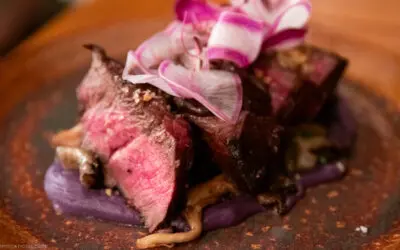***We’re heartbroken after a devastating wildfire tore through our historic town of Lahaina on August 8, 2023, burning down 5 square miles of local homes and businesses. The rebuild will take years, and we’re monitoring the situation closely to keep our readers as best informed as possibly can. West Maui is open to responsible, mindful, and respectful visitors starting October 8, 2023. If you are wanting to help, we encourage you to volunteer on your visit to Maui***

©Polinahe Photography
One of the most memorable aspects of a visit to Maui is the opportunity to experience the rich Hawaiian culture and history of the islands. You cannot visit the Hawaiian Islands without, in some way, being exposed to its deeply-rooted heritage, whether through food, dance, music, plants, language, legends, or arts and crafts — like these beautiful lei, made of shells, feathers, and seeds. The Native Hawaiian culture is at the very heart of our islands, and it makes Hawaii completely unique from any other destination in the world.

Statue of King Kamehameha I on the island of Oahu.
It is believed that the first Hawaiians came from islands in the south/central Pacific somewhere around the 4th century, and that by the 1700s the Hawaiian population may well have been as large as 300,000, spread across the various islands. The islands were left undisturbed by Western influence until the 1778 arrival of Captain James Cook, followed by the missionaries. King Kamehameha I, a great warrior and diplomat, was Hawaii’s first king, uniting all of the islands under one royal kingdom in 1810 after years of warfare.

Hawaiian ki‘i (tiki) carving. ©Polinahe Photography
Four principal gods, represented by ki‘i (tiki), formed the basis of the Hawaiian religion, and today the stone foundations of heiau (ancient places of worship) can still be seen on Maui. In addition, certain animals — such as the shark, Hawaiian green sea turtle, humpback whale, and Hawaiian owl — are considered by Native Hawaiians to be ancestors or family guardians (‘aumakua), and these animals are treated with great respect.

Hawaiian implements at Kaanapali Beach Hotel. ©Polinahe Photography
In recent decades, there has been a renaissance of Hawaiian culture and language and a renewed dedication towards preserving and presenting Hawaiian cultural practices with accuracy and integrity. There are many respected cultural practitioners who work within the visitor industry to educate and inform our island guests about the native culture. Accommodations, activities, restaurants, tours, shopping centers…all of these are making an effort now to provide opportunities for visitors to experience Hawaii’s culture in an authentic and respectful manner. Take advantage of these opportunities, as they will greatly enhance your Maui experience.

Ancient petroglyphs in Olowalu, Maui. ©Polinahe Photography
When you visit Maui, you will likely hear Hawaiian being spoken, a language made up of only 5 vowels and 8 consonants, one of which is an ‘okina — a symbol similar to a backward apostrophe which signifies a glottal stop. Proper spelling of the Hawaiian language also includes the kahakō, a macron over a vowel to indicate a long vowel sound. The use of the ‘okina and kahakō are critical in defining the meanings behind similar words. For instance, the word ono is a fish, but add the ‘okina and the word ‘ono means “delicious.” (NOTE: We recognize and respect the significance of the ‘okina and kahakō markings in the written Hawaiian language; however, on our website we have chosen to omit those diacritical markings on certain words — such as Hawai‘i and Moloka‘i — in order to integrate smoothly with the more common spellings people use in online searches.) More information on the Hawaiian language here.

Hula dancers at Napili Kai Beach Resort
You will undoubtedly experience hula during your visit. In ancient times, hula was an integral part of religious ceremonies and rituals. The graceful dance conveys a story or message through hand and body movements, accompanied by chant or song, and is still considered sacred by Hawaiians today.

Pounding poi at a local Hawaiian festival
There are plenty of museums, festivals, programs, and tours that will immerse you in Hawaiian culture. And if you attend a luau, you’ll have a chance to see and hear traditional Hawaiian songs, chant, and dances, as well as sample poi—a taro-based staple of the Hawaiian diet for centuries. (Poi is also available in island grocery stores, by the way, if you decide you really love it!)
So take time out from your sightseeing and beachcombing and whale watching to savor the essence of the beautiful and unique heritage that surrounds you. Mahalo for being respectful and sensitive towards our Native Hawaiian culture. An appreciation and understanding of the local culture will only serve to enrich your visit to Maui.

©Polinahe Photography
- Looking for great places to stay on Maui? You’ll save by BOOKING DIRECTLY with the owners/managers of these accommodations.
- Looking for Maui deals? Sign up here for our free monthly Maui Deals & Steals enewsletter with the latest book-direct deals from our advertisers.

 Aloha! Tiffany here. I've been blessed to call Maui home since 2011. With a background in the island's finest restaurants and hotels, guiding visitors to create unforgettable Maui memories is more than a skill I've mastered—it's a profound source of joy for me.
Aloha! Tiffany here. I've been blessed to call Maui home since 2011. With a background in the island's finest restaurants and hotels, guiding visitors to create unforgettable Maui memories is more than a skill I've mastered—it's a profound source of joy for me.





